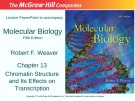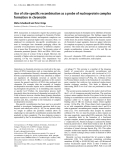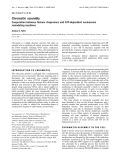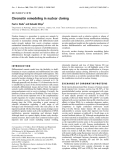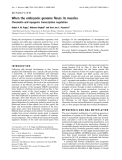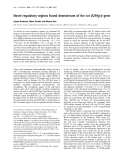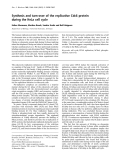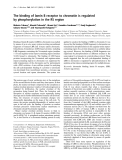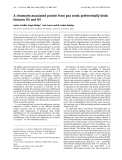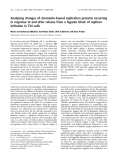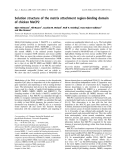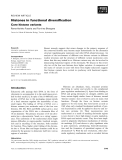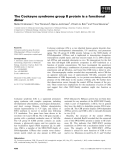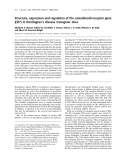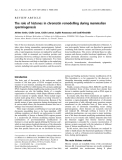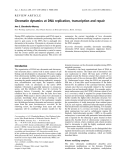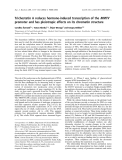
Chromatin structure
-
Chapter 13 - Chromatin structure and its effects on transcription. In this chapter, we will look at the crucial relationship among activators, chromatin structure, and gene activity. This chapter presents the following content: Histones, nucleosomes, chromatin structure and gene activity.
 40p
40p  tangtuy05
tangtuy05
 30-03-2016
30-03-2016
 77
77
 3
3
 Download
Download
-
DNA transactions in eukaryotes require that proteins gain access to target sequences packaged in chromatin. Further, interactions between distinct nucleoprotein complexes are often required to generate higher-order structures. Here, we employed two prokaryotic site-specific recombination systems to investigate how chromatin packaging affects the assembly of nucleoprotein structures of different complexities at more than 30 genomic loci. The dynamic nature of chromatin permitted protein–DNA and DNA–DNA interactions for sites of at least 34 bp in length.
 7p
7p  system191
system191
 01-06-2013
01-06-2013
 50
50
 4
4
 Download
Download
-
Hypoxia interrupts the initiation of simian virus 40 (SV40) replication in vivo at a stage situated before unwinding of the origin region. After re-oxygenation, unwinding followed by a synchronous round of viral replication takes place. To further characterize the hypoxia-induced inhibition of unwinding, we analysed the binding of several replication proteins to the viral minichromosome before and after re-oxygenation.
 11p
11p  research12
research12
 01-06-2013
01-06-2013
 41
41
 4
4
 Download
Download
-
Chromatin is a highly dynamic structure that plays an essential role in regulating all nuclear processes that utilize the DNA template including DNA repair, replication, transcription and recombination. Thus, the mechanisms by which chromatin structures are assembled and modified are questions of broad interest. This minireview will focus on two groups of proteins: (a) histone chaperones and (b) ATPdependent chromatin remodeling machines, that co-operate to assemble DNA and histone proteins into chromatin....
 7p
7p  research12
research12
 01-06-2013
01-06-2013
 32
32
 4
4
 Download
Download
-
Nuclear cloning is a procedure to create new animals by injecting somatic nuclei into unfertilized oocytes. Recent successes in mammalian cloning with differentiated adult nuclei strongly indicate that oocyte cytoplasm contains unidentified remarkable reprogramming activities with the capacity to erase the previous memory of cell differentiation. At the heart of this nuclear reprogramming lies chromatin remodeling as chromatin structure and function define cell differentiation through regulation of the transcriptional activities of the cells....
 4p
4p  research12
research12
 01-06-2013
01-06-2013
 42
42
 4
4
 Download
Download
-
The organization of DNA within eukaryotic cell nuclei poses special problems and opportunities for the cell. For example, assembly of DNA into chromatin is thought to be a principle mechanism by which adventitious general transcription is repressed. However, access to genomic DNA for events such as DNA repair must be facilitated by energy-intensive processes that either directly alter chromatin structure or impart post-translational modifications, leading to increased DNA accessibility.
 6p
6p  research12
research12
 01-06-2013
01-06-2013
 36
36
 4
4
 Download
Download
-
During the development of multicellular organisms, both transient and stable gene expression patterns have to be established in a precisely orchestrated sequence. Evidence from diverse model organisms indicates that this epigenetic program involves not only transcription factors, but also the local structure, composition, and modification of chromatin, which define and maintain the accessibility and transcriptional competence of the nucleosomal DNA template.
 6p
6p  research12
research12
 01-06-2013
01-06-2013
 33
33
 4
4
 Download
Download
-
To search for novel regulatory regions, we examined the features of chromatin structure in the rat B29/Ig-b gene and its flanking regions by determining DNase I hypersensitive sites (DHS) in plasmacytoma-derived Y3 cells. Six Y3 cellspecific DHS were detected at )8.6, promoter, +0.7, +4.4, +6.0, and +8.7 kb. The DHS at +4.4, +6.0, and +8.7 kb were present in the intergenic region between B29/Ig-b and growth hormone (GH) genes and were mapped inside conserved sequences in rat and humans.
 10p
10p  research12
research12
 01-06-2013
01-06-2013
 29
29
 4
4
 Download
Download
-
The human replication protein Cdc6p is translocated from its chromatin sites to the cytoplasm during the replication phase (S phase) of the cell cycle. However, the amounts of Cdc6p on chromatin remain high during S phase implying either that displaced Cdc6p can rebind to chromatin, or that Cdc6p is synthesized de novo. We have performed metabolic labeling experiments and determined that [35S]methionine is incorporated into Cdc6p at similar rates during the G1 phase and the S phase of the cell cycle. Newly synthesized Cdc6p associates with chromatin....
 7p
7p  research12
research12
 01-06-2013
01-06-2013
 39
39
 3
3
 Download
Download
-
Binding of lamin B receptor (LBR) to chromatin was studied by means of an in vitro assay system involving recombinant fragments of human LBR and Xenopus sperm chromatin. Glutathione-S-transferase (GST)-fused proteins including LBR fragments containing the N-terminal region (residues 1–53) and arginine-serine repeat-containing region (residues 54–89) bound to chromatin. The binding of GST-fusion proteins incorporating the N-terminal and arginine-serine repeat-containing regions to chromatin was suppressed by mild trypsinization of the chromatin and by pretreatment with a DNA solution....
 11p
11p  research12
research12
 01-06-2013
01-06-2013
 29
29
 4
4
 Download
Download
-
Pisum sativump16 is a protein present in the chromatin of ungerminated embryonic axes. The purification of p16 and the isolationof a cDNAclone ofpsp54, the gene encoding its precursor have been recently reported [Castillo, J., Rodrigo, M. I.,Ma´rquez, J. A., Zu´n˜iga, AandFranco, L. (2000)Eur. J.Biochem.267, 2156–2165]. In thepresentpaper,wepresent data showing that p16 is a nuclear protein.
 8p
8p  research12
research12
 23-04-2013
23-04-2013
 34
34
 2
2
 Download
Download
-
It was shown previously [Riedinger, H. J., van Betteraey-Nikoleit, M & Probst, H. (2002)Eur. J. Biochem.269, 2383–2393] that initiation ofin vivo SV40 DNA replication is reversibly suppressed by hypoxia in a state where viral minichromosomes exhibit a nearly complete set of repli-cation proteins. Reoxygenation triggers fast completion and post-translational modifications.
 11p
11p  tumor12
tumor12
 20-04-2013
20-04-2013
 30
30
 2
2
 Download
Download
-
Báo cáo khoa học: Solution structure of the matrix attachment region-binding domain of chicken MeCP2
Methyl-CpG-binding protein 2 (MeCP2) is a multifunc-tional protein involved in chromatin organization and silencing of methylated DNA. MAR-BD, a 125-amino-acid residue domain of chicken MeCP2 (cMeCP2, origin-ally named ARBP), is the minimal protein fragment required to recognize MAR elements and mouse satellite DNA. Here we report the solution structure of MAR-BD as determined by multidimensional heteronuclear NMR spectroscopy.
 8p
8p  tumor12
tumor12
 20-04-2013
20-04-2013
 36
36
 2
2
 Download
Download
-
Recent research suggests that minor changes in the primary sequence of the conserved histones may become major determinants for the chromatin structure regulating gene expression and other DNA-related processes. An analysis of the involvement of different core histone variants in different nuclear processes and the structure of different variant nucleosome cores shows that this may indeed be so. Histone variants may also be involved in demarcating functional regions of the chromatin.
 20p
20p  fptmusic
fptmusic
 12-04-2013
12-04-2013
 38
38
 4
4
 Download
Download
-
Cockayne syndrome (CS) is a rare inherited human genetic disorder char-acterized by developmental abnormalities, UV sensitivity, and premature aging. The CS group B (CSB) protein belongs to the SNF2-family of DNA-dependent ATPases and is implicated in transcription elongation, transcription coupled repair, and base excision repair. It is a DNA stimula-ted ATPase and remodels chromatin in vitro. We demonstrate for the first time that full-length CSB positively cooperates in ATP hydrolysis as a function of protein concentration....
 9p
9p  fptmusic
fptmusic
 11-04-2013
11-04-2013
 41
41
 2
2
 Download
Download
-
The role of DNase I hypersensitive sites (DHSs) in transcription of the B cell-specificIg-bgene and in maintenance of active chromatin state in the Ig-b locus were examined. A total of 10 DHSs were divided into four regions, and each region was deleted separately in chicken B lymphocyte-derived DT40 cells. Deletion of three DHSs located between theIg-bpro-moter and its upstreamNa channelgene, resulted in the absence of Ig-b mRNA. Three regions except the region in theNa channelgene were involved in the transcription of Ig-bgene. ...
 11p
11p  awards
awards
 05-04-2013
05-04-2013
 36
36
 2
2
 Download
Download
-
Loss of cannabinoid receptors (CB1) occurs prior to neuro-degeneration in Huntington’s disease (HD). The levels and distribution of CB1 RNA were equivalent in 3-week-old mice regardless of genotype demonstrating that the specific factors and appropriate chromatin structure that lead to the transcription ofCB1were present in the striatum of young R6/2 and R6/1 transgenic HD mice.
 12p
12p  awards
awards
 05-04-2013
05-04-2013
 55
55
 5
5
 Download
Download
-
HAND2/dHAND is a basic helix-loop-helix transcription factor expressed in the heart and neural crest derivatives during embryogenesis. Although dHAND is essential for branchial arch, cardiovascular and limb development, its target genes have not been identified. The regulatory mech-anisms of dHAND function also remain relatively unknown. Here we report that Akt/PKB, a serine/threonine protein kinase involved in cell survival, growth and differ-entiation, phosphorylates dHAND and inhibits dHAND-mediated transcription....
 11p
11p  awards
awards
 05-04-2013
05-04-2013
 45
45
 5
5
 Download
Download
-
During DNA replication, transcription and DNA repair in eukaryotes, the cellular machineries performing these tasks need to gain access to the DNA that is packaged into chromatin in the nucleus.Chromatin is a dynamic structure thatmodulates the access of regulatory factors to the genetic material.A precise coordination and organization of events in opening and closing of the chromatin is crucial to ensure that the correct spatial and temporal epigenetic code is maintained within the eukaryotic genome....
 15p
15p  dell39
dell39
 03-04-2013
03-04-2013
 42
42
 4
4
 Download
Download
-
The deacetylase inhibitor trichostatin A (TSA) has long been used to study the relationship between gene transcrip-tion and the acetylation status of chromatin. We have usedXenopus laevisoocytes to study the effects of TSA on glucocorticoid receptor (GR)-dependent transcription and we have related these effects to changes in the chromatin structure of a reporter mouse mammary tumor virus (MMTV) promoter. We show that TSA induces a low level of constitutive transcription.
 10p
10p  dell39
dell39
 03-04-2013
03-04-2013
 53
53
 6
6
 Download
Download
CHỦ ĐỀ BẠN MUỐN TÌM








